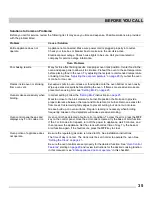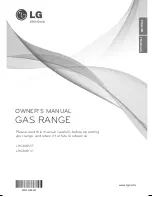
30
CARE AND CLEANING
.
Aluminum Foil and Utensils
Porcelain-enameled broiler pan
and insert
Porcelain door liner
Porcelain body parts
Rinse with clean water and a damp cloth. Scrub gently with a soapy, non-abrasive
scouring pad to remove most spots. Rinse with a 50/50 solution of clean water and
ammonia. If necessary, cover difficult spots with an ammonia-soaked paper towel for
30 to 40 minutes. Rinse and wipe dry with a clean cloth. Remove all cleaners or
future heating could damage the porcelain. Do not allow food spills with a high sugar
or acid content (milk, tomatoes, sauerkraut, fruit juices or pie filling) to remain on
porcelain surfaces. These spills may cause a dull spot even after cleaning.
Oven Interior
Use Steam Clean for minor soils on oven cavity.
If cleaning oven interior manually, use mild dish detergent and water or a 50/50
solution of vinegar and water to clean.
Ammonia must be rinsed thoroughly before operating the oven. Provide adequate
ventilation.
Oven door
Use mild dish detergent and water or a 50/50 solution of vinegar and water to clean
the top, sides, and front of the oven door. Rinse well. Glass cleaner may be used on
the outside glass of the door. Ceramic smoothtop cleaner or polish may be used on
the interior door glass. Do not immerse the door in water.
Do not spray or allow water or cleaners to enter the door vents. Do not use oven
cleaners, cleaning powders, or any harsh abrasive cleaning materials on the outside
of the oven door.
Do not clean the oven door gasket. The oven door gasket is made of a woven
material which is essential for a good seal. Do not rub, damage, or remove this
gasket.
Gas cooktop surface burners
See
Gas cooktop surface grates
Gas cooktop burner caps
Use a non-abrasive plastic scrubbing pad and mild abrasive cleanser. Do not allow
food spills with a high sugar or acid content (milk, tomatoes, sauerkraut, fruit juices or
pie filling) to remain on the burner grates or burner caps. These spills may cause a
dull spot even after cleaning. Clean these spills as soon as surfaces are cool. Thor-
oughly dry immediately following cleaning.
•
Never cover any slots, holes, or passages in the oven
bottom or cover an entire oven rack with materials
such as aluminum foil. Aluminum foil linings may trap
heat, causing a fire hazard.
•
Protective Liners — Do not use aluminum foil to line
the oven bottom. Improper installation of these liners
may result in risk of electric shock or fire.
WARNING
•
Aluminum foil - Use of aluminum foil on a hot cooktop
can damage the cooktop. Do not use thin aluminum
cooking utensils or allow aluminum foil to touch the
surface elements under any circumstances.
•
Aluminum utensils - The melting point of aluminum is
much lower than that of other metals. Care must be
taken when aluminum pots or pans are used on the
cooktop. If aluminum pans are allowed to boil dry
when using the cooktop, not only will the utensil be
damaged or destroyed, but it may fuse to, break, or
mark the ceramic glass surface, permanently
damaging the cooktop surface.
IMPORTANT








































